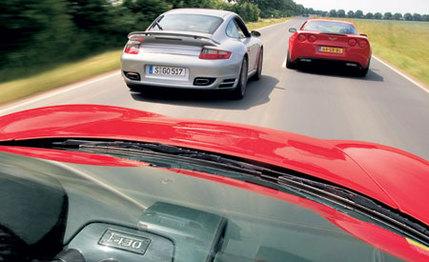
 Comparison Tests
Comparison Tests
The arrival of a new Porsche 911 Turbo is an event that's as significant and riveting for car enthusiasts as the winner of American Idol seems to be for the majority of adult Americans. The Turbo is important because it has resided at the pinnacle of the 911 line since it first went on sale in the U.S. in 1976 and has thus been a perennial contender for the title of best darned sports car on the planet.
The 2007 Turbo is a development of the Type 997 version of the 911, which was introduced two years ago in Carrera and Carrera S forms. Externally, there's little chance of confusing it with its lesser brethren, thanks to a huge biplane rear wing, wider rear wheel arches, stunning 19-inch wheels, and more scoops than a Baskin-Robbins shop. Inside, leather swathes seemingly every surface, but otherwise the car is differentiated from cheaper 911s only by Turbo graphics on the sills and gauges and a unique shifter.
Of course, the real reason the Turbo's base price of $123,695 is about 40 grand more than that of a Carrera S is because it's a showcase for Porsche's most high-tech performance pieces. The horizontally opposed 3.6-liter engine isn't actually the same one found in the Carrera but is a development of the dry-sump unit fitted in the previous-generation Turbo and GT3 and the new GT3. It has a bigger bore and shorter stroke than the Carrera engine and also uses a separate crankcase and cylinder blocks. (The Carrera engine is cast with the crankcase and cylinder blocks as one unit.)
In common with the outgoing turbo engine, VarioCam Plus variable camshaft timing is used to alter valve lift and timing, and the exhaust valves are sodium filled to aid cooling. Unlike in the previous engine, the twin turbochargers feature variable vanes. At low rpm, the vanes close to speed up the exhaust gases and reduce turbo lag, but they open at higher speeds for maximum power. The turbo bearing cases are now water cooled. The upshot is an output of 480 horsepower and maximum torque of 457 pound-feet. (With the optional Sport Chrono package, there's an overboost function that increases turbo pressure by about 2.9 psi, giving maximum torque of 502 pound-feet.)
Like all 911 Turbos going back to the 1995 993, this one has all-wheel drive. The outgoing model used a center viscous coupling, but the new car features an electromagnetically controlled clutch pack at the center differential. This is a major component of the Porsche Traction Management system. Reading data from the onboard sensors, PTM shunts torque between the front and rear axles to reduce understeer or oversteer, to preload the clutch for maximum traction at launch, or to minimize wheelspin on slippery surfaces. The Turbo also has the Porsche Stability Management (PSM) and Porsche Active Suspension Management (PASM) stability-control and electronic-damping systems. A rear-locking differential is optional (our car had it) on models fitted with the six-speed manual transmission, but not on cars that have the five-speed Tiptronic manumatic.
Taking its cue from the Carrera GT, the Turbo has six-piston front-brake calipers, which here act on 13.8-inch-diameter vented discs. There's the option of even larger 15.0-inch discs with the $8840 ceramic composite option. Thanks partly to aluminum doors, the new Turbo weighs about the same as the outgoing car, but it's still the porker of this group at 3514 pounds.
We were expecting the '07 Turbo to be special, but just how good is it? To find out, we traveled to Germany and brought along a Ferrari F430 and Chevrolet Corvette Z06 for comparison. Those both provide similar amounts of horsepower and performance for wildly differing amounts of money — a base of $65,690 for the 505-hp Corvette and a whopping $174,535 for the 483-hp F430.
For various reasons, Ferrari couldn't provide us with a car because the company was at full stretch with the launch of the 599GTB, but we suspect it was gun-shy about putting its car up against the Corvette. However, Gerrit Schumann, an Internet entrepreneur we know in Germany, generously lent us his car for a couple of days. He wasn't too keen on our running standing starts, having fried a clutch when using the launch-control function, so we took the standing-start acceleration and braking results from our "Lords of Envy" comparison [C/D, August 2005]. In Europe, we stormed the German autobahns and back roads and tested at the magnificent Papenburg facility in northern Germany, which features a 7.6-mile-long high-speed oval and a replica of the short course at Hockenheim, home of the German Grand Prix.